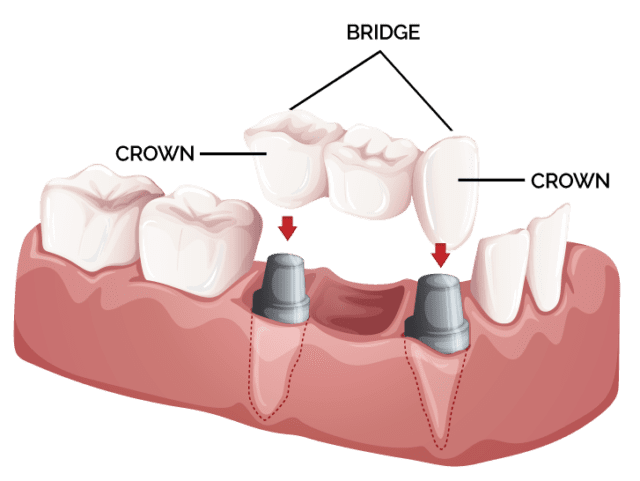December 25, 2025
Crowns vs Bridge
What’s the Difference Between Dental Crowns & Bridges? 
A dental crown can cap an individual’s damaged or decaying tooth. It is also placed on top of a dental implant to replace a missing tooth. Dental implants are metal fixtures, surgically fastened to your jawbone below the gums. These metal implants become anchored to your bone through osseointegration (the bone fuses to the metal). This process provides stable support you can rely on while eating and speaking. According to the Cleveland Clinic, the healing process after getting an implant can take 6-12 weeks. Your dental professional will then place a metal post (or abutment) into your implant, onto which they will mount your crown. Crowns & Bridges can help you restore your smile.
Bridges, on the other hand, are solely used to replace missing teeth. The crowns at the ends of a bridge can fuse to existing teeth, or your dental professional can attach them to dental implants.
Whichever of these replacement tooth options is best for you – they can be vital in maintaining your oral health. Gaps in areas of loss can cause your other teeth to begin rotating or shifting into the empty spaces, resulting in a bad bite. And missing teeth can even lead to gum disease and temporomandibular joint (TMJ) disorders.
When Crowns Are Necessary
Protect Your Damaged Tooth
Dental crowns cover up and protect damaged teeth, and they are beautifully crafted from porcelain to look and feel just like a natural tooth. We use Crowns to restore teeth if you have a large cavity that is cannot is impossible to fix with a filling. If you have had root canal therapy and need a supportive structure to protect your tooth from further damage. Crowns are also used for cosmetic purposes to cover up teeth that are slightly damaged, misshapen, stained, or have other cosmetic flaws.
What to Expect
The Dental Crown Process
The crown placement process is minimally invasive and only takes two appointments. To begin the process, one of our dentists will numb and clean the area. We remove any damaged enamel from your tooth to create a healthy, stable platform for your dental crown.
We then take impressions and images of your mouth and send them to an outside lab where they fabricate a custom dental crown. This crown will match your teeth in size, shape, and color.
After this appointment, you’ll be sent home with a temporary crown until your permanent restoration arrives at our office. When we receive your permanent crown, you’ll come back to our office for your final appointment. One of our dentists will attach the crown to your tooth using special dental cement, and you’ll leave our office with a beautiful, fresh smile.
Understanding Dental Bridges
How Bridges Replace Missing Teeth
Dental bridges comprise two dental crowns and at least one false tooth. We attach the dental crowns to healthy teeth on either side of the gap that is left behind from your missing tooth. This creates a bridge. The bridge holds a dental crown in place to restore the function and beauty of your smile. Bridges are a cost-effective way to get your smile back if you have one or more missing teeth. This option is typically more comfortable and stable than partial dentures.
How it Works
Dental Bridge Treatment
Firstly you will receive an anesthetic and your dentist prepares your abutment teeth (the teeth on either side of the gap) to receive a dental bridge. We then take impressions and images of your mouth and used them to craft your customized bridge. We’ll give you a temporary bridge to wear while we manufacture your permanent restoration.
When your permanent bridge arrives, one of our dentists will check to make sure that it fits perfectly, and bond into place using powerful dental cement. After your final appointment, you’ll leave our office with a complete, confident smile.
What You Need to Know about Crowns & Bridges
Bridges vs. Other Replacement Options
Dental bridges can restore a patient’s smile if a tooth has been knocked out or extracted due to extensive damage or decay. Bridges are a great replacement option if your jaw bone is not strong or sufficient enough to support a dental implant. Bridges are also less invasive than implant surgery. As a result, they are an ideal choice for patients who fear more extensive dental procedures. At My Dental Club, we use high-quality materials and our skilled dentists ensure that your bridge will be durable and look beautiful.
Care & Maintenance of Crowns & Bridges
How to Care
Caring for a dental crown is just like caring for your natural teeth. It’s important to brush twice per day and floss once per day. Crowns can become decayed and infected without proper care. Other than daily oral hygiene and routine preventive care at My Dental Club, there is no special care required for crowns!
Regular brushing and flossing are also key to taking proper care of dental bridges. To clean around your bridge, it’s important to floss between the gum and the base of the bridge. Ensuring that all plaque removal from under the false tooth is important.
Care & Maintenance of Crowns & Bridges
How long do they last
Sometimes crowns and bridges can become loose or fall out. This is a result of damage caused by chewing hard foods, ice, or other hard objects. Dental disease that causes tooth or bone loss is another reason crowns or bridges may loosen over time.
By practicing good oral hygiene, however, crowns and bridges can last for a long time. Brush at least twice a day, floss or clean between your teeth with interdental brushes. Be sure to see your dental professional for regular cleanings. This is not only to keep your teeth pearly white and bacteria-free but also to check the health of your crown or your bridge. Whether you and your dentist decide on a crown or a bridge for your replacements, we hope your new teeth make you smile.
Book a visit to My Dental Club, simply fill out the form and we will contact you back regarding the intervention you require.




